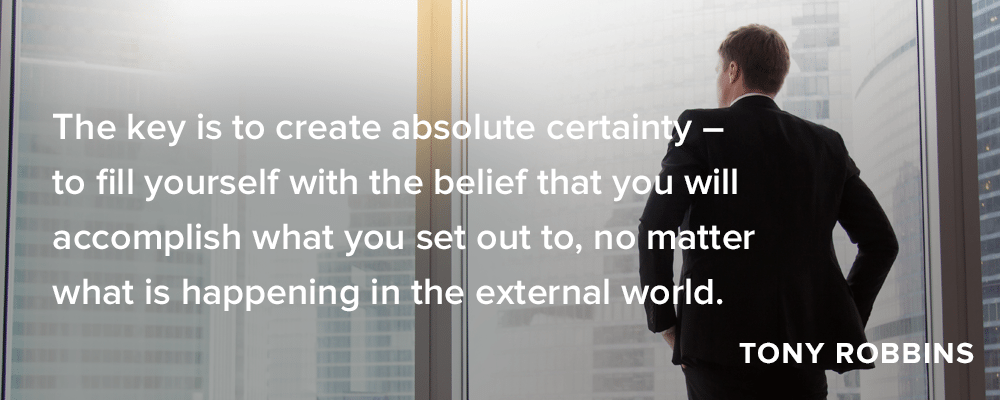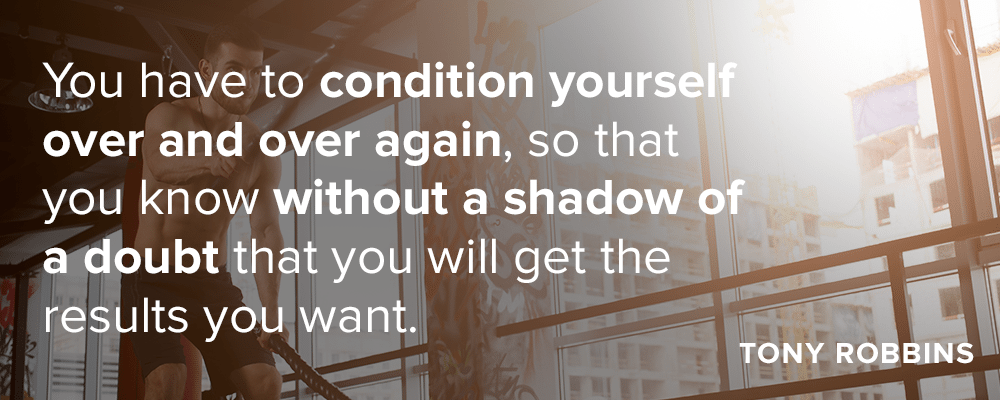Team Tony cultivates, curates and shares Tony Robbins’ stories and core principles, to help others achieve an extraordinary life.
The power of mental conditioning
How imagery training can you help you maximize your performance
What is the distinguishing factor between someone who takes action and someone who doesn’t? It’s one word: certainty.
Think about it. If you are absolutely certain that you will get the result you want, and that result would be life-changing, you will take massive action. On the other hand, if you are absolutely sure that no matter what you do, it just won’t work, you’re not going to spend any time making any real moves.
Of course, these are the extremes. Most of us find ourselves somewhere in the middle ground – the no-man’s land of “maybe it will work, maybe it won’t.” And this is the real danger zone. Because we end up making half-hearted efforts rather than putting our heart and soul into it.
The key is to create absolute certainty – to fill yourself with the belief that you will accomplish what you set out to, no matter what is happening in the external world. You have to get the results in your head that make you feel certain, as if it has already happened. And one of the best ways to do this is through imagery training.

WHAT IS IMAGERY TRAINING?
Consider Roger Bannister. For centuries, it was believed that running a 4-minute mile was physically impossible. But Roger Bannister shattered that myth. How did he do it?
Roger didn’t just go out and physically practice, he made a mental shift as well. He practiced, over and over in his head. He envisioned himself breaking that 4-minute barrier. Because he knew that no matter how much he trained his body, if he was going to get the result he wanted, he had to change his mental state first. He conditioned himself to become so certain that he was capable of achieving this feat, that he believed he would do it with every fiber of his being.

After Roger Bannister ran that 4-minute mile, within just two years, 37 people also ran a 4-minute mile. And remember, no one in history had ever done that before.
This is the power of imagery training – of visualizing the results over and over, as if it had already happened.
We all have beliefs that limit us. Sometimes we let the status quo set dictate what we believe is possible. Other times we allow our own self-doubt take precedent. Other times, we may have unconscious beliefs that hold us back.
Imagery training is a technique that lets us overcome those limitations. We are able to see ourselves succeeding – not just on a high level, but on a very detailed, precise way. We see what the results look like, and we envision the way in which we will prevail. What’s interesting about it, too, is that in doing this, we immerse ourselves in the emotions that are part of that success, that experience. Because it is not just a mental exercise, it becomes a fully-body experience that impacts you psychologically, emotionally and physically. And it’s that all-encompassing dynamic that helps produce absolute certainty, which allows you to transcend the boundaries that you had imposed (perhaps unwittingly) on yourself before.
A RITUAL FOR SUCCESS
The potential to achieve anything you want is always there. But whether you tap into that potential has everything to do with you. Most people have a strong belief about what their real potential is, and that influences how much action they take. Then the action they take determines their results, and ironically, those results reinforce their pre-existing beliefs.
If it’s a must for you, you have to make it work. You have to enter the mindset that no matter what, you will make a way. That is how you go from earning $300 a week to $1000 to $1 million. It’s why the rich get richer and the poor get poorer.
But imagery training is not a one-and-done exercise. It’s a ritual. You have to condition yourself over and over again, so that you know without a shadow of a doubt that you will get the results you want.

4 KEYS TO IMAGERY TECHNIQUE
While there is no precise method, there are some fundamental components to an effective imagery training practice.
1. Take an outside perspective.
Picture yourself as if from above, or outside of your body, as you go through the motions. For example, if it is a pitch you are preparing for, see yourself walking into the room. How composed is your posture? What are you wearing? Witness the look of determination on your face. Then watch yourself nail the presentation. How do you appear? Are you are comfortable, relaxed, poised and sure of yourself?
2. Focus on the mistakes.
While this may sound counterintuitive, the goal is to pay extra attention to areas of poor performance – because those reflect inherent insecurities you may have. If you start to see the faces of your audience look unimpressed and that impacts your presentation, that may reflect a deep-seated lack of confidence in your ability to deliver the pitch. Take note of that instance, so you can then practice on how you would react. Then replay that scene over and over until you get it right and are able to maintain your composure throughout the entire presentation. The end goal is to be able to make an automatic shift when a negative thought or emotion enters your space.
3. Create a multi-sensory experience.
Feel the confidence exuding from you as you enter the room. Don’t just imagine, experience what it would be like to crush the pitch. What are the sounds in the room? Is there background noise? How do you sound? How do the faces of the people in the room appear? Feel how comfortable, relaxed and sure of yourself you are while delivering the pitch. Feel the energy in the room. This practice will help translate technically and tactically to your body. You will be able to carry yourself with confidence, and you will be better able to mimic a smooth performance when it comes to the actual pitch if you have made a ritual of creating a mind-body connection.
4. Write a highly detailed written account of the process.
Put as much action into the script as possible. Describe the feelings you experience. Detail the sounds. Take note of everything you see. Even write down what you would do to a negative component that enters your mind – that is, automatically dismiss any thought or emotion that does not serve you. Then, read your story over and over again. Or better yet, record it and play it in your car while you are driving or walking. The goal is to firmly engrain the experience you desire in your mind and to get you to embody the version of yourself that you know you can be.


